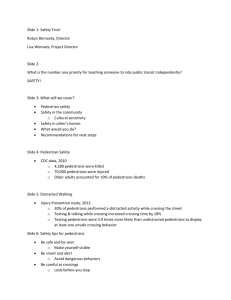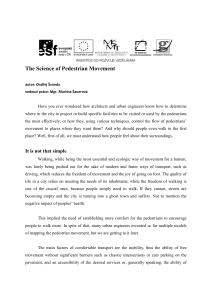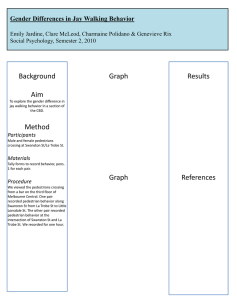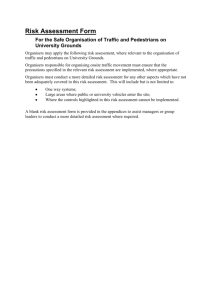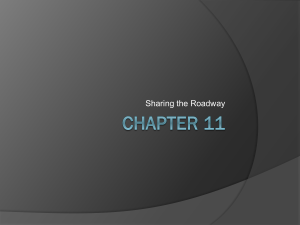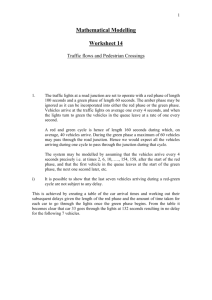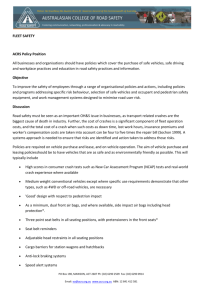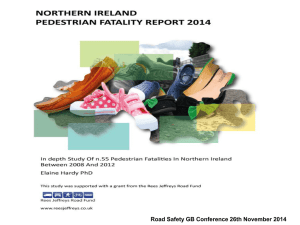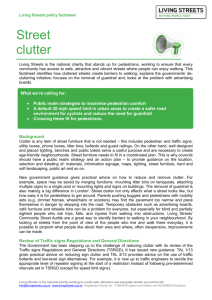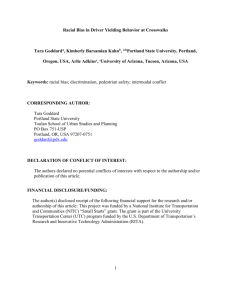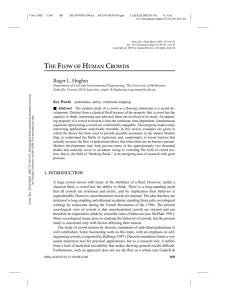Pedestrians
advertisement
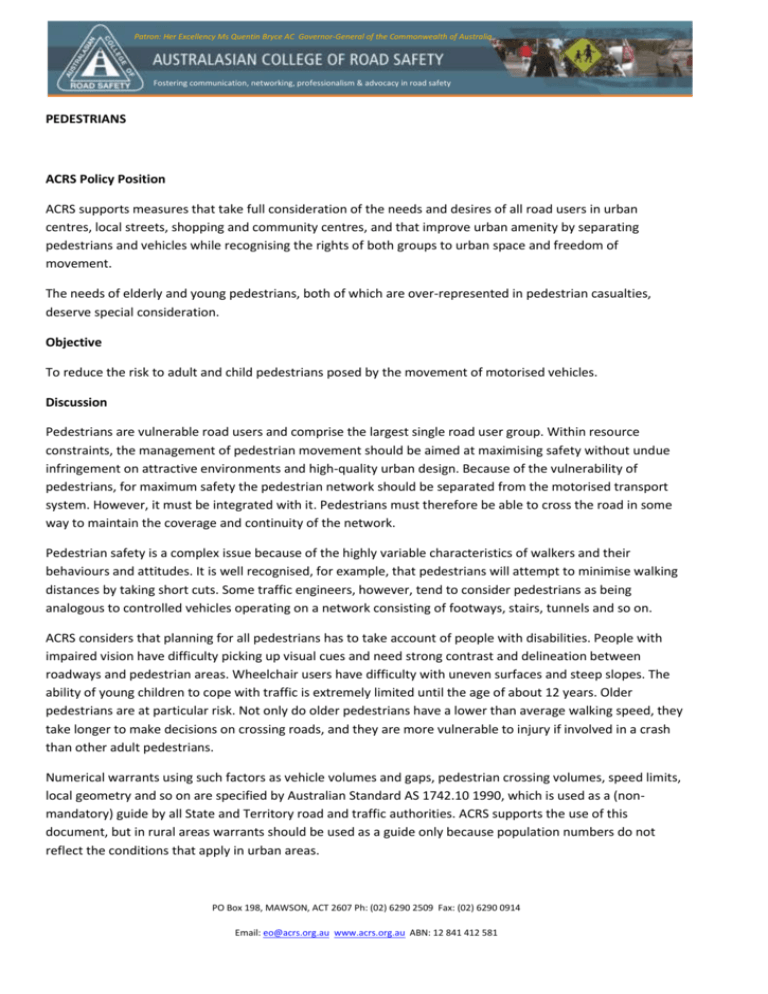
Patron: Her Excellency Ms Quentin Bryce AC Governor-General of the Commonwealth of Australia Fostering communication, networking, professionalism & advocacy in road safety PEDESTRIANS ACRS Policy Position ACRS supports measures that take full consideration of the needs and desires of all road users in urban centres, local streets, shopping and community centres, and that improve urban amenity by separating pedestrians and vehicles while recognising the rights of both groups to urban space and freedom of movement. The needs of elderly and young pedestrians, both of which are over-represented in pedestrian casualties, deserve special consideration. Objective To reduce the risk to adult and child pedestrians posed by the movement of motorised vehicles. Discussion Pedestrians are vulnerable road users and comprise the largest single road user group. Within resource constraints, the management of pedestrian movement should be aimed at maximising safety without undue infringement on attractive environments and high-quality urban design. Because of the vulnerability of pedestrians, for maximum safety the pedestrian network should be separated from the motorised transport system. However, it must be integrated with it. Pedestrians must therefore be able to cross the road in some way to maintain the coverage and continuity of the network. Pedestrian safety is a complex issue because of the highly variable characteristics of walkers and their behaviours and attitudes. It is well recognised, for example, that pedestrians will attempt to minimise walking distances by taking short cuts. Some traffic engineers, however, tend to consider pedestrians as being analogous to controlled vehicles operating on a network consisting of footways, stairs, tunnels and so on. ACRS considers that planning for all pedestrians has to take account of people with disabilities. People with impaired vision have difficulty picking up visual cues and need strong contrast and delineation between roadways and pedestrian areas. Wheelchair users have difficulty with uneven surfaces and steep slopes. The ability of young children to cope with traffic is extremely limited until the age of about 12 years. Older pedestrians are at particular risk. Not only do older pedestrians have a lower than average walking speed, they take longer to make decisions on crossing roads, and they are more vulnerable to injury if involved in a crash than other adult pedestrians. Numerical warrants using such factors as vehicle volumes and gaps, pedestrian crossing volumes, speed limits, local geometry and so on are specified by Australian Standard AS 1742.10 1990, which is used as a (nonmandatory) guide by all State and Territory road and traffic authorities. ACRS supports the use of this document, but in rural areas warrants should be used as a guide only because population numbers do not reflect the conditions that apply in urban areas. PO Box 198, MAWSON, ACT 2607 Ph: (02) 6290 2509 Fax: (02) 6290 0914 Email: eo@acrs.org.au www.acrs.org.au ABN: 12 841 412 581 ACRS recognises that grade separation for pedestrians provides the highest degree of priority for both walkers and for vehicles. However, reasons against providing such facilities include a high capital cost, and it has been shown in most countries that in general they are poorly patronised on roads where traffic is already interrupted by traffic signals. Further, there are difficulties in encouraging the use of overpasses and underpasses by the aged and the physically disabled. Pedestrian overpasses or underpasses are not normally employed except where large numbers of pedestrians have to cross freeways and high-speed, high-volume trunk roads. Such cases may justify the high costs involved, or address specific matters of community concern such as the proximity of a large school or railway station. ACRS believes that as a matter of principle, both pedestrians and drivers should approach any pedestrian crossing with care. Any device giving a pedestrian an illusory sense of safety can add to danger. Measures that might be applied to help vulnerable groups include: Education of younger children about the dangers of crossing roads Education and increased awareness of parents of the limitations of children in traffic and the dangers to children as pedestrians Education of older pedestrians about the increased danger they face because of reduced mobility Providing better facilities to compensate such as median refuges, pelican/puffin crossings, improved land use planning, traffic light phasing. PO Box 198, MAWSON, ACT 2607 Ph: (02) 6290 2509 Fax: (02) 6290 0914 Email: eo@acrs.org.au www.acrs.org.au ABN: 12 841 412 581
